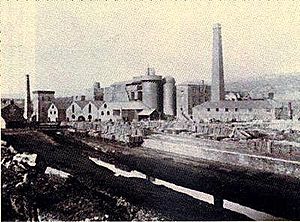Cinderford Ironworks facts for kids
Quick facts for kids Cinderford Ironworks |
|
|---|---|

c1890. Cinderford Ironworks
|
|
| Location | Gloucestershire, England, UK |
| OS grid reference | SO 65036 12910 |
| Lua error in Module:Location_map at line 420: attempt to index field 'wikibase' (a nil value). | |
The Cinderford Ironworks, also known as Cinderford Furnace, was a factory that made iron. It used a special type of oven called a blast furnace. This furnace was powered by coke, which is a fuel made from coal. The ironworks was built in 1795. It was located just west of Cinderford in the Forest of Dean, Gloucestershire, England.
Contents
Making Iron in the Forest of Dean
The Forest of Dean was very important for making iron for hundreds of years. It had lots of iron ore, which is the rock from which iron is taken. There was also plenty of timber, which was used to make charcoal. Charcoal was the main fuel for making iron back then.
The name Cinderford might even come from the word sinders. This word means clinker, which is the waste left over from early Roman iron factories. The word ford probably means a place where people crossed the Cinderford Brook.
New Ways to Make Iron
The first blast furnace that used coke was built in 1709. This happened in a place called Coalbrookdale in Shropshire. Even though the Forest of Dean had a lot of coal, the local coal didn't make the best coke for melting iron. Because of this, iron makers in the area were slow to try the new coke-fired method.
It wasn't until the late 1700s that coke furnaces started to appear in the Forest of Dean. The Cinderford, Whitecliff, and Parkend Ironworks were all built around the same time.
History of Cinderford Ironworks
Work on the Cinderford Ironworks began in 1795. It was the first coke-fired blast furnace in the Forest of Dean. It likely started making iron in 1797 or 1798. Thomas Teague was the main person who pushed for its construction. We don't know who else helped pay for it.
Coal was brought to the ironworks by boat. It came along the Cinderford Canal from Broadmoor, which was just north of the site. Iron ore was carried by mules from mines like Edge Hill.
Early Challenges
The ironworks was running in 1806. However, like Parkend Ironworks, it probably stopped making iron around 1807. The reasons are not fully clear. But the factory was only making less than 20 tons of iron a week. This was a very small amount. The problems might have been due to a lack of skill or because the local coke wasn't good enough. It could have been both.
A New Discovery and Reopening
Around 1820, Moses Teague made an important discovery. He was working at Darkhill Ironworks. He found a way to make good iron using local coke. To use his new method, he reopened Parkend Ironworks in 1824. Then, he reopened Cinderford Ironworks in 1829.
The factory stopped working again in 1832. This was during a time when the economy was not doing well. But it started up again in 1835. This was possible with money from William Crawshay. He was a Welsh iron maker from the Cyfarthfa Ironworks.
Years of Success
The Cinderford Ironworks did very well for the next forty years. A second furnace was added around 1835. By 1841, there were three furnaces. They were making 12,000 tons of iron each year. A fourth furnace was added sometime before 1855.
Henry Crawshay, William's son, took over running the works in 1847. In 1862, he bought out the only other business partner, Stephen Allaway.
The End of an Era
By the late 1870s, the iron business faced tough times. Only two furnaces were still making iron. Two new furnaces were built in 1880. But by 1890, only one was in use. The Cinderford Ironworks closed its doors in 1894. The buildings were completely taken down by 1901.
Today, you can hardly see any remains of the ironworks above the ground.


